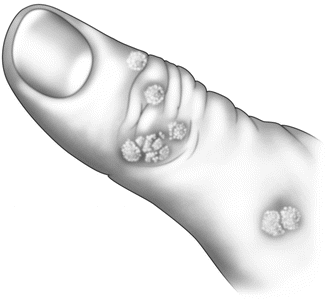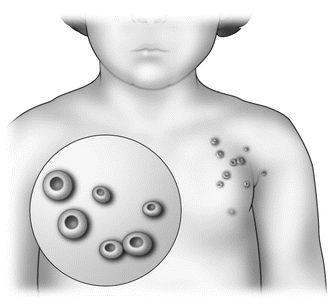, Toral Patel3, 4, Neill T. Peters3, 2 and Sarah Kasprowicz5
(1)
Northwestern University Feinberg School of Medicine, Chicago, IL, USA
(2)
Medical Dermatology Associates of Chicago, Chicago, IL, USA
(3)
Instructor of Clinical Dermatology, Northwestern University Feinberg School of Medicine, Chicago, IL, USA
(4)
D&A Dermatology, Chicago, IL, USA
(5)
NorthShore University HealthSystem, University of Chicago, Pritzker School of Medicine, Chicago, IL, USA
Keywords
WartsMolluscum contagiosumZincGarlicPropolisCantharidinLemon myrtleIntroduction
Despite the fact that they are benign and generally self-limited, warts and molluscum are responsible for an inordinately high percentage of dermatology consultations: warts alone constitute some 21% of all dermatology referrals (Boull and Groth 2011), while molluscum has an estimated prevalence in children of up to 11.5% (Olsen et al. 2014).
Warts are caused by the human papillomavirus (HPV) and can infect epithelial and mucosal tissue throughout the body. Certain strains have predilections for particular body areas, such as HPV-2, HPV-27, and HPV-57 for warts on the hands and feet (Tomson et al. 2011). Although warts often appear as solitary, defined lesions, the virus may be present at distant sites and may persist for many years. Conventional therapy is focused on stimulating the innate immune response to the virus via tissue destruction and irritation (Micali et al. 2004). This comes to bear on the fact that over half of patients report moderate-to-severe discomfort from their warts (Ciconte et al. 2003), an aspect of warts that is often overlooked, and is almost certainly exacerbated by destructive and irritating therapies. Thus, it is possible that for this reason, or perhaps because of the fact that even the best conventional therapies rarely demonstrate efficacy above 60% that many are drawn to alternative treatments.
The molluscum contagiosum virus (MCV) is the poxvirus responsible for the small, dome-shaped, umbilicated papules of molluscum. Similar to warts, these generally benign lesions can spread via water, such as baths and pools, and from close contact. Molluscum is more common in children with atopic dermatitis, suggesting a role for skin barrier function in their prevention (Braue et al. 2005). Patients often present with multiple lesions, and there may be an associated dermatitis that can complicate matters clinically and add to the discomfort. Conventional therapy is nearly identical to that of warts, with an emphasis on destruction and irritation, including cryotherapy, curettage, and topical salicylic acid. As with warts, some conventional therapies may make things worse (Katz 2014), thus opening up the possibility for nonconventional treatments.
Clinical Considerations
Top Considerations for Warts
See Table 12.1.
Table 12.1.
Top considerations for wart treatment.
Treatment | How administered | Notes |
|---|---|---|
Propolis | Orally at 500 mg daily | Safe, inexpensive, may have immunomodulatory effects; risk of allergy in bee-sensitive population |
Zinc | Orally at 10 mg/kg/d up to 600 mg/d of zinc sulfate; topically as 20% ointment or 10% solution twice daily | Relatively safe, fairly compelling evidence; significant rate of nausea and gastrointestinal distress for oral administration |
Garlic | Freshly cut piece rubbed to lesions at night | Safe, inexpensive, likely works by irritant mechanism but may have anti-viral effects as well; can be very irritating and damaging if piece of garlic affixed to skin, extract preparation not readily available |
Propolis
Propolis is a botanical, resinous mixture that serves as a sealant in bee hives, and has been used since antiquity as a medicine (Kuropatnicki et al. 2013). In more modern times, it has shown promise as an immunomodulator, suggesting a mechanism of action in this setting (Sforcin 2007).
Evidence for Propolis
1.
Propolis as an alternative treatment for cutaneous warts. Zedan H, Hofny ER, Ismail SA. Int J Dermatol. 2009 Nov;48(11):1246–9.
135 patients were examined in a single-blind, randomized controlled trial on warts. The propolis was dosed at 500 mg per day for 3 months and cure was found in 73% of patients with common warts compared to only 8% in the placebo group.
Zinc
Zinc may play a role in immunity against viruses, and levels have been found to be deficient in some patients with refractory warts (Lazarczyk et al. 2008). There are data for both oral zinc with its significant risk of nausea, as well as topical preparations that do not share this unpleasant side effect in the treatment of warts.
Evidence for Zinc
1.
Oral zinc sulfate treatment for viral warts: an open-label study. Mun JH, Kim SH, Jung DS, Ko HC, Kim BS, Kwon KS, Kim MB. J Dermatol. 2011 Jun;38(6):541–5.
In an open-label study of 31 patients with multiple warts, oral zinc sulfate (10 mg/kg/d up to a maximum of 600 mg/day) was administered for 2 months. Of those who completed the study, 50% showed complete resolution, but a notable 16% reported nausea and 3% developed gastric pain.
2.
Evaluation of oral zinc sulfate effect on recalcitrant multiple viral warts: a randomized placebo-controlled clinical trial. Yaghoobi R, Sadighha A, Baktash D. J Am Acad Dermatol. 2009 Apr;60(4):706–8.
A randomized, placebo controlled, double blinded trial of oral zinc sulfate (same dosing as above) for patients with multiple recalcitrant warts. After 2 months, 25/32 patients (78%) of the zinc group cleared compared to only 3/23 (13%) of controls, and this was significant.











